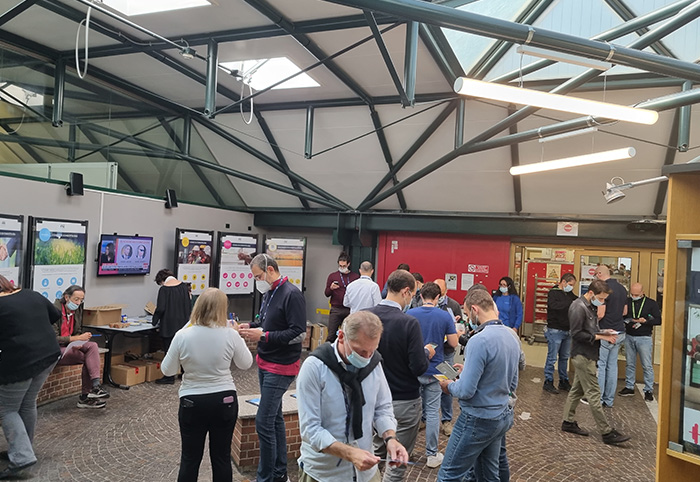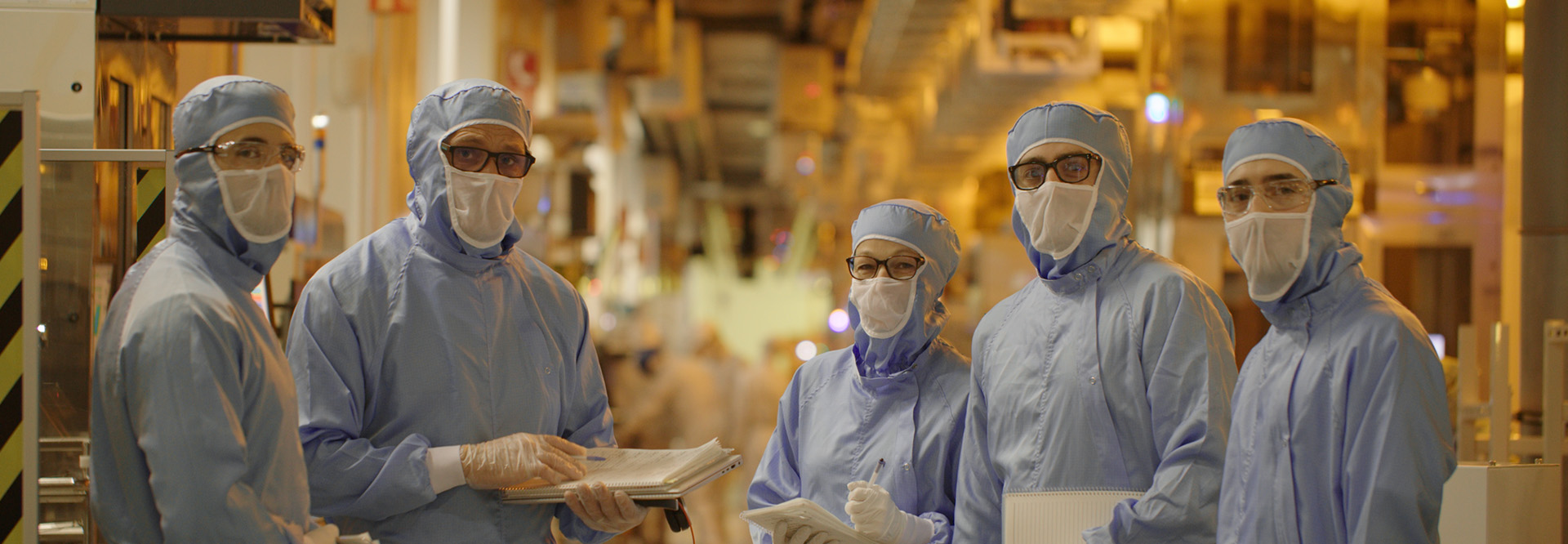Labor and human rights
We are convinced that companies play a vital role in respecting labor and human rights and we strive to be a role model.
79%
of employees covered by RBA audits
9
core principles in our due diligence approach
29
points above industry average RBA audit score
Labor and human rights are a fundamental part of our culture and history. We believe companies play a vital role in implementing, respecting, and promoting labor and human rights. Our programs aim to ensure all our people are treated with respect and dignity, both within our own operations and throughout our supply chain (see Responsible supply chain).
The main management systems and programs we use to monitor, control and improve labor conditions in our operations are:
- a Corporate Labor and Human Rights policy and annual goals across our operations (available at www.st.com)
- an internal audit program on labor and human rights, targeting our manufacturing sites
- Responsible Business Alliance (RBA) human rights self-assessments at all major ST sites, and third-party RBA audits at our 11 largest manufacturing sites
- multiple initiatives to uphold human rights and mitigate risks in regions where we operate
I 3-3 I 2-23 I
Integrating human rights into our business
As a member of the RBA since 2005 (and currently a full member), we enforce the highest human rights standards. We have a comprehensive due diligence process that covers our potential and actual positive and negative impacts through nine core principles.
Freely chosen employment
ST does not use forced labor, including bonded, trafficked or slave labor, or involuntary or exploitative prison labor.
Prevention of underage labor and protection of young workers
ST does not use child labor and protects young workers under the age of 18 to ensure they are not exposed to hazardous work.
Fair organization of working time
ST maintains reasonable working hours and sufficient rest, in compliance with applicable laws and industry standards.
Fair wages and benefits
ST offers wages in compliance with all applicable laws, including minimum wages, overtime hours and legally mandated benefits.
Fair treatment, anti-harassment
ST does not tolerate any mistreatment of a worker by another worker; all workers must be treated fairly.
Non-discrimination
ST maintains a culture free of discrimination, where all individuals are treated with respect and dignity, and provides equal opportunities.
Freedom of association
At ST, employees are free to choose whether or not to organize and join trade unions and bargain collectively.
Fair working conditions and employee well-being
ST provides a safe and healthy working environment, conducive to employee well-being.
Privacy of personal information
ST safeguards the privacy of all personal data gathered.
Any concerns related to these principles can be reported through our grievance mechanism (see Ethics and compliance). | 3-3 |
Our approach
We apply a process based on RBA methodology to continually improve our management systems and mitigate or prevent any human rights abuses.
Commitment
We are committed to the RBA code of conduct and integrate its principles into our internal policies:
We deliver regular labor and human rights training at our manufacturing sites.
- More than 30 employees have attended RBA in-person training to enable them to deploy the RBA code of conduct and Validated Assessment Program (VAP) audit standard.
- In 2022, we trained 48% of our manufacturing employees on the RBA code of conduct, particularly on labor and human rights issues relevant for the local context.
Communication
We communicate how we are addressing our risks and impacts.
- Our performance is reported publicly every year in our annual sustainability report.
Risk assessment
We conduct regular risk assessments to identify and evaluate actual or potential adverse human rights impacts.
Our risk assessment is based on:
- An assessment of the inherent risks related to our activities and locations.
- RBA risk self-assessment questionnaires, which our sites complete each year. In 2022, our sites scored from 60/100 to 95/100. Our sites’ average score is 79/100, which is higher than the industry average of 73/100.
- A site-specific assessment to identify the labor and human rights risks associated with local operations at our major sites.
Audit programs
We run audit programs covering our manufacturing sites (79% of our employees).
- Our internal audits monitor compliance with our Corporate Labor and Human Rights policy (covering our nine core principles). They are conducted across all our manufacturing sites at least every 3 years.
- RBA third-party audits are conducted at our 11 largest manufacturing sites every 2 years, including closure audits when relevant.
Improvement actions
We identify and implement appropriate actions to prevent and mitigate adverse human rights impacts.
- Following a risk assessment, we develop and implement mitigation actions to prevent or minimize any labor and human rights impacts identified.
- Our internal and external audit results are followed up at both site and corporate level. Where appropriate, we implement corrective action plans to resolve any issues identified, and we verify completion of the actions.
Performance monitoring and review
We track and measure our progress to continuously improve our performance.
- We regularly monitor and review site performance against specific objectives and targets.
- We track our action plans to measure and improve their effectiveness in addressing adverse human rights impacts.
Commitment
We are committed to the RBA code of conduct and integrate its principles into our internal policies:
We deliver regular labor and human rights training at our manufacturing sites.
- More than 30 employees have attended RBA in-person training to enable them to deploy the RBA code of conduct and Validated Assessment Program (VAP) audit standard.
- In 2022, we trained 48% of our manufacturing employees on the RBA code of conduct, particularly on labor and human rights issues relevant for the local context.
Communication
We communicate how we are addressing our risks and impacts.
- Our performance is reported publicly every year in our annual sustainability report.
Risk assessment
We conduct regular risk assessments to identify and evaluate actual or potential adverse human rights impacts.
Our risk assessment is based on:
- An assessment of the inherent risks related to our activities and locations.
- RBA risk self-assessment questionnaires, which our sites complete each year. In 2022, our sites scored from 60/100 to 95/100. Our sites’ average score is 79/100, which is higher than the industry average of 73/100.
- A site-specific assessment to identify the labor and human rights risks associated with local operations at our major sites.
Audit programs
We run audit programs covering our manufacturing sites (79% of our employees).
- Our internal audits monitor compliance with our Corporate Labor and Human Rights policy (covering our nine core principles). They are conducted across all our manufacturing sites at least every 3 years.
- RBA third-party audits are conducted at our 11 largest manufacturing sites every 2 years, including closure audits when relevant.
Improvement actions
We identify and implement appropriate actions to prevent and mitigate adverse human rights impacts.
- Following a risk assessment, we develop and implement mitigation actions to prevent or minimize any labor and human rights impacts identified.
- Our internal and external audit results are followed up at both site and corporate level. Where appropriate, we implement corrective action plans to resolve any issues identified, and we verify completion of the actions.
Performance monitoring and review
We track and measure our progress to continuously improve our performance.
- We regularly monitor and review site performance against specific objectives and targets.
- We track our action plans to measure and improve their effectiveness in addressing adverse human rights impacts.
Our audit programs
We run internal audits on labor and human rights at our manufacturing sites, and third-party RBA VAP audits at our 11 largest manufacturing sites. These audits highlight any gaps at the sites, help to identify areas that require improvement, and strengthen the local social responsibility culture.
In 2022, we conducted five labor and human rights internal audits. For this audit cycle, around 45% of the areas identified for improvement were related to management systems and 55% to labor and human rights core principles.
For RBA VAP (6.0/7.0) third-party audits, all 11 of our manufacturing sites eligible for the audit program have been audited within the last 2 years, either in an initial audit or a closure audit, or both.
- Our best performers with full compliance during the initial audit were our Agrate (Italy) and Calamba (the Philippines) sites.
- Initial audit results at our Muar (Malaysia) and Shenzhen (China) sites were well above the industry average of 144/200.
- For closure audits, our Crolles, Rousset and Tours sites (France), and our Bouskoura site (Morocco) were fully compliant, with a score of 200/200.
- Our Ang Mo Kio site (Singapore) managed to resolve 100% of the 11 non-conformances identified during the initial audit in March 2022, including the priority finding related to our on-site contractors’ working hours.
Our average RBA audit score is above the industry average: +29 points in initial audits and +19 points in closure audits.
The main non-conformances identified during third-party RBA audits in 2022 are shown in the table below.
Number of audits: 10 |
|
|
|
||||
Total of priority or major non-conformances |
|||||||
Labor, Ethics |
Health and Safety |
||||||
|---|---|---|---|---|---|---|---|
Working hours |
2 |
Occupational injury and illness |
2 |
||||
Wages and benefits |
1 |
Food, sanitation and housing |
2 |
||||
Freely chosen employment |
2(1) |
Occupational safety |
1 |
||||
Non-discrimination |
1 |
Physically demanding work |
1 |
||||
Management systems |
|
Environment |
|
||||
Legal and customers requirements |
1 |
Hazardous substance |
2 |
||||
Training |
1 |
|
|
||||
|
|||||||
Country |
Site |
SAQ score(1) |
VAP score(2) |
||||||||
|---|---|---|---|---|---|---|---|---|---|---|---|
High risk |
|||||||||||
China |
Shenzhen |
63.5 |
180.7 |
||||||||
Malaysia |
Muar |
75.9 |
164.7 |
||||||||
Singapore |
Ang Mo Kio |
59.6 |
200 |
||||||||
The Philippines |
Calamba |
65.3 |
200 |
||||||||
Medium risk |
|||||||||||
Malta |
Kirkop |
83.6 |
200(3) |
||||||||
Morocco |
Bouskoura |
75.0 |
200 |
||||||||
Low risk |
|||||||||||
France |
Crolles |
86.3 |
200 |
||||||||
Rousset |
84.9 |
200 |
|||||||||
Tours |
83.5 |
200 |
|||||||||
Italy |
Agrate |
78.5 |
200 |
||||||||
Catania |
78.5 |
200(3) |
|||||||||
|
|||||||||||
Following both internal and external audits, we have implemented improvement plans to reinforce existing social management systems.

Shahrom Tumin
HR Director, ST Muar (Malaysia)
I have been working on labor and human rights programs for 12 years. It’s very rewarding to see our progress and the benefits that are delivered. ST is now widely recognized for its efforts to address labor and human rights issues and we are considered a leading employer by prospective employees in sourcing countries. We work closely with the RBA office in Malaysia and are regularly invited to share our experience with other companies. We were also proud to participate in a government consultation on the new National Action Plan for Forced Labor 2021–2025, which aims to eliminate forced labor in Malaysia.”
Our risks and improvement actions
In 2022, the main risks we identified and the preventive and remediation actions we implemented are detailed in the table below.
Description |
Actions implemented |
|---|---|
Control and monitoring of working hours (including rest days) |
|
Prevention of forced and bonded labor |
|
Student protection and management |
|
Awareness of RBA standard and workers’ rights |
|
Our improvement action plans are defined at site level with the relevant stakeholders. They are then reviewed and challenged at corporate level to enhance our management systems, share best practices, reduce risks, and identify opportunities.
They include:
- determination of root cause(s)
- description of the preventive and corrective actions to address the root cause(s) identified and prevent future recurrence of the issue(s)
- the date the actions are expected to be completed
These action plans are defined, implemented, and reviewed following defined timelines, and we verify that the findings are closed. They may address policy or procedure changes, communication or training, activity, and impact measurements. l 409-1 l
FOCUS

Continuously improving awareness on workers’ rights
In addition to regular online or in-person training, our Agrate and Castelletto sites (Italy) launched their first ‘RBA day’ on October 26 and November 22, respectively. This event took place during the lunchbreak to improve workers’ awareness of their labor rights and our commitment to each pillar of the RBA standard: labor and human rights, health and safety, environment, ethics, and supply chain management. The event featured a booth with posters and brochures explaining the RBA requirements, RBA-trained employees presenting the standard and answering questions, and a quiz for workers to challenge themselves on their knowledge of the RBA standard. More than 750 workers participated in the quiz at both sites, and the results demonstrated that the participants had a high level of awareness. To conclude, all participants left with a small gardening kit with the reminder ‘RBA day – forget me not’.
Going beyond labor and human rights
Since its launch in March 2020, our STCare program has been improved to go beyond psychosocial risk prevention and protection, and employee assistance (see Health and safety).
In 2022, we expanded STCare to cover employee well-being, based on four domains:
- effective leadership
- caring culture
- working environment
- wellness benefits
We will define and implement a global framework with minimum standards in 2023, based on internal and external best practices.
Our sites implemented many initiatives to nurture employee well-being. For example, our Bouskoura site (Morocco) has built an on-site nursery that can host up to 40 children from 3 months to 4 years old to support our employees in parenthood and ensure a better work-life balance.
Contributing to the Sustainable Development Goals
Our commitments and programs as described above contribute to:
SDG target 8.7 – Take immediate and effective measures to eradicate forced labor, end modern slavery and human trafficking, and secure the prohibition and elimination of the worst forms of child labor.
SDG target 8.8 – Protect labor rights and promote safe and secure working environments for all workers.
SDG target 17.16 – Enhance the global partnership for sustainable development, complemented by multi-stakeholder partnerships that mobilize and share knowledge, expertise, technology and financial resources, to support the achievement of the sustainable development goals in all countries, in particular developing countries.
2025 sustainability goal |
Status |
Comments |
||
SG5: Get 100% of ST's largest manufacturing sites recognized for social responsibility by external international bodies by 2025. |
91% of largest manufacturing sites |
|||
|
||||
Annual sustainability goal |
Status |
Comments |
100% of priority, major and minor non-conformities closed during the RBA closure audit (annual objective) |
100% of findings closed (25/25) |
|
100% of all manufacturing sites audited every 2 years for compliance with the RBA standard (annual objective) |
100% of our largest manufacturing sites audited (11/11) |


